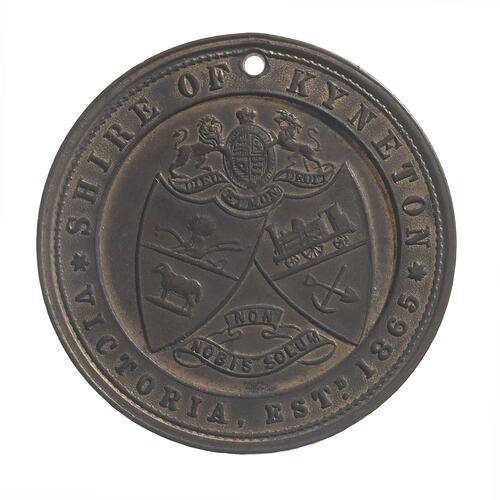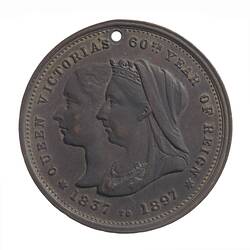The Shire of Kyneton was located in Victoria's central highlands, crossed by the Campaspe River. The original inhabitants of the region covered by the Shire of Kyneton were the DjaDja Wurrung people, although the area was bordered by other indigenous people. The party of explorer Thomas Mitchell crossed the river at or near the future townsite of Kyneton in 1836. He named it the 'Campaspe' after one of Alexander the Great's courtesans.
The first squatter, C.H. Ebden, arrived in 1837, establishing the 'Karlsruhe' station (hence the town of Carlsruhe just to the south of Kyneton). In 1844 the Jeffrey brothers purchased the Karlsruhe station. Mrs Jeffrey suggested the settlement be named 'Kington' after property the family once owned in Kington, Herefordshire, on the Welsh border. Other squatters followed. A corn mill was in operation by 1841. The following year two shepherds were killed during a confrontation with the indigenous community. Mounted police pursued the party in question, killing six people.
In 1849 Superintendent Charles Latrobe selected a site for the township on the Jeffrey brothers' station. The town was laid out by Surveyor Foote and approved as a township in 1850, before Victoria was proclaimed a State.
The town grew significantly during the gold rush, providing food and shelter for prospectors en route to the goldfields of Clunes, Castlemaine and Bendigo. All of the major bluestone buildings that still exist in Kyneton were constructed at this time. From 1851 prospectors referred to the town as 'Kyneton', from the archaic 'kyne', meaning cow. It is unclear which origin of the name Kyneton is correct.
In 1858 Caroline Chisholm lived at Kyneton, where her family owned a store and her husband was a magistrate. Here she began to establish a series of inexpensive overnight shelter sheds for travellers on the Mount Alexander Road (now the Calder Highway).
Kyneton was proclaimed a municipality in 1857. The rail link from Melbourne arrived in 1862, further boosting the fortunes of the town. The Shire of Kyneton was proclaimed a shire on 18 January 1865. In the 1890s the state's first pasteurizing plant was introduced at Kyneton.
In the twentieth century Kyneton became the agricultural centre envisioned by LaTrobe.
Kyneton sent troops to every armed conflict in Australian history. The Prince of Wales Light Horse began in Kyneton, and locally-born Alex Burton won a Victoria Cross at Lone Pine, Gallipoli. The area has also produced a Captain of Australian cricket, and been instrumental in the education of two premiers, two prime ministers, a war secretary & a treasurer of N.S.W.
On 19 January 1995 parts of the Shires of Kyneton and Talbot and the Shires of Creswick, Daylesford and Glenlyon, and Clunes united to form Hepburn Shire Council. The remainder of the Shire and the Shires of Gisborne, Romsey and Newham and Woodend became part of the Macedon Ranges Shire Council.
References:
Municipal Association of Victoria website http://www.mav.asn.au/mavsite.nsf, accessed 9/10/2003. (Reviewed 2024.)
Blake, L. (1977). Place Names of Victoria.
People's Voice: Australian Community History On-line website - accessed 09/10/2003.
(Website no longer active when reviewed 2024.)
Fairfax Walkabout Travel Guide website - accessed 09/10/2003.
(Website no longer active when reviewed 2024.)
More Information
-
Keywords
-
Localities
-
Authors
-
Article types

